모유 이외 다른 보조 영양분을 더 먹이려면 Breastfeeding and supplemental feeding
모유수유와 보조 영양 Breastfeeding and supplemental feeding
1. 물과 수분
- “젖 먹는 아기에게 맹물을 따로 먹여도 되느냐”고 묻는 수유모들도 있다.
- 모유 100cc 속에 든 수분의 양은 약 87cc이다.
- 아기가 젖만 충분히 먹어도 모유에서 섭취한 수분으로 정상적으로 성장 발육할 수 있다.
- 모유 이외 물을 많이 먹이면 오히려 아기가 소변을 자주 많이 볼 수 있고, 엄마의 젖을 적게 먹을 수 있다.
- 아기가 있는 실내의 온도와 습도가 적절하고 아기가 육체적으로 보통 활동할 때 젖을 충분히 먹는 아기에게 물을 따로 더 먹일 필요가 없다. 단, 무더운 여름철이나, 실내의 온도가 상당히 높을 때, 땀을 많이 흘릴 때는 젖 먹는 아기에게 끓여 식힌 보리차 물이나 맹물을 우유병으로 가끔 먹일 수 있다.
- 젖 먹는 아기가 대변을 매일 보지 않거나 2~3일마다 보거나 한두 번 정도 보면 변비가 있다고 걱정하는 수유모도 있다.
- 나이에 따라 맹물을 가끔 먹이면 대변을 질게 볼 수 있다.
- 생후 4개월 이전에는 끓여 식힌 맹물을 먹일 수 있고, 그 이후부터는 끓이지 않은 식수를 그냥 먹여도 된다.
- 탈수되면 소변보는 간격이 길어지고 소변의 양도 적어진다.
- 탈수가 됐다고 의심되면 젖도 충분히 먹이고 맹물을 추가로 더 먹일 수 있다.
- 수유모가 보통 때보다 수분을 더 섭취하면 젖이 더 많이 분비되고, 아기에게 맹물을 따로 먹일 필요도 없다.
2 비타민제
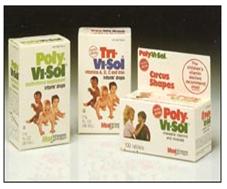
사진 4-96.영유아용 종합비타민제 드롭
소스: Used with permission from Mead Johnson Nutritionals,USA
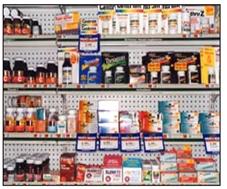
사진 4-97.동네 약국에 진열된 여러 종류의 비타민제
Copyright ⓒ 2011 John Sangwon Lee, MD., FAAP
- 분만 후 6~9개월까지 균형 잡힌 음식물을 충분히 섭취한 수유모의 젖을 먹고 자란 영아들은 그들이 필요로 하는 각종 비타민을 모유에서 충분히 섭취할 수 있다.
- 반면, 수유모가 음식물을 골고루 섭취하지 못했거나 충분히 먹지 않았을 때는 영아들이 필요로 하는 비타민과 미네랄 등을 모유에서 충분히 섭취할 수 없다.
- 생후 3~4개월부터 철분과 비타민 A·B·D가 든 종합비타민제 드롭을 젖 먹는 영아들에게 의사의 처방에 따라 먹이기도 한다.
- 생후 4개월 이후부터 젖 먹는 영아들에게 철분이 든 영아용 종합비타민제 드롭을 통상적으로 먹여도 된다.
- 그리고 불소제 드롭을 의사의 지시에 따라 먹인다.
- 모유를 먹인 갓 태어난 신생아에게도 비타민 K 주사를 병원 신생아실에서 통상적으로 놓아준다.
표 5-2. 비타민이 많이 들어있는 음식물과 비타민 종류
| 비타민의 종류 | 많이 들어있는 음식물 | 비타민의 종류 | 많이 들어있는 음식물 |
| 비타민 A | 버터, 달걀, 간 등 | 피리독신 | 간, 육류, 곡물류, 옥수수, 콩 등 |
| 프로비타민 A | 암록 색 채소류, 노란 과일과 채소류, 토마토 등 | 리보플라빈 | 육류, 우유, 달걀, 푸른 채소류, 곡물류 등 |
| 비오틴 | 간, 달걀노른자, 땅콩 등 | 티아민 | 간, 육류, 우유, 곡물류 등 |
| 비타민 B12 | 육류, 우유, 달걀 등 | 비타민 C | 신 과일, 토마토, 양배추, 감자, 모유 등 |
| 엽산 | 간, 푸른 채소류, 곡물류, 오렌지 등 | 비타민 D | 비타민 D를 첨가한 우유, 생선, 간, 정어리, 고등어, 연어, 달걀노른자 등 |
| 니아신 | 육류, 생선, 푸른 채소류, 곡물류 등 | 비타민 E | 땅콩, 두유, 버터, 곡물류 기름 등 |
| 펜터넥닉산 | 대부분의 음식물에 포함되어 있음 | 비타민 K | 우유, 푸른 채소, 돼지고기, 간 등 |
|
미숙 신생아에게 인공영양과 모유를 먹일 때 |
Breast milk with Infant formula feeding for premature infants
- 만삭에 태어난 건강한 신생아들이나 큰 미숙 신생아들, 저체중 신생아들이 필요로 하는 영양분(탄수화물, 지방, 단백질, 수분, 미네랄, 비타민 A, B, C, D 등 비타민, 미네랄 그리고 성장 발육에 필요한 모든 영양분이 모유 속에 적절히 충분히 들어 있다.
- 따라서 균형 잡힌 음식물을 충분히 섭취하는 엄마의 젖을 먹는 만삭에 태어난 신생아들에게는 종합 비타민제와 철분제를 따로 더 먹일 필요가 없다.
- 그러나 젖 먹는 미숙 신생아들은 의사의 처방에 따라 종합 비타민제와 철분을 따로 더 먹는 것이 좋다.
- 의사의 지시가 없는 한, 인공영양을 먹는 만삭에 태어난 신생아, 저체중 신생아들이나 미숙 신생아들에게는 비타민 등 다른 영양분을 더 먹일 필요가 없다. 그러나 가능한 한 초유를 꼭 먹이고 모유수유로 키우는 것이 좋다.
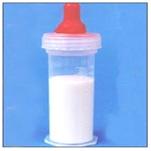
사진 4-98. 저체중 신생아들이나 미숙 신생아들이 인공영양을 먹기 좋게 만든 미숙 신생아용 우유병
Copyright ⓒ 2012 John Sangwon Lee, MD., FAAP
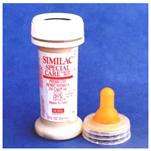
사진 4-99. 아주 작은 미숙 신생아들이나 저체중 신생아들에게는 필요에 따라 고 칼로리 특수 포뮬라를 먹일 수 있다. 예를 들면 인공영양 30CC에 24kcl의 열량이 생성되는 미숙 신생아용 특수 인공영양도 있다.
Copyright ⓒ 2012 John Sangwon Lee, MD., FAAP
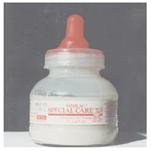
사진 4-100. 저체중 신생아들이나 미숙 신생아들에게 먹이는 특수 인공영양. 단위용량의 인공영양에 들어있는 칼로리 양이 더 많게 제조한다.
Copyright ⓒ 2012 John Sangwon Lee, MD., FAAP
|
다음은 “미숙 신생아 영양”에 관한 인터넷 소아청소년 건강상담 질의응답의 예 입니다. |
Q.&A. ‘미숙 신생아 영양’에 관한 인터넷 질의응답
Q.
6개월 된 남자아이인데 1.7kg으로 태어나 인큐베이터에 한 달 동안 입원해 있었습니다. 퇴원해서 백일까지는 다른 아이들처럼 잘 먹고 잘 자랐는데 백일 지나면서 아기가 잘 먹지를 않습니다. 하
루에 500ml 정도 밖에 먹질 않습니다. 아기가 잘 먹는 주기가 있고, 안 먹는 주기가 있다는 말을 듣고 계속 지켜보고 이유식도 해봤으나 변함이 없습니다. 이유식을 하면 분유는 더 먹질 않습니다. 그렇다고 해서 이유식을 많이 먹지도 않습니다. 왜 그런지 걱정입니다. 좋은 말씀 있으시면 부탁드립니다.
A.
장군님
안녕하십니까. 질문해 주셔서 감사합니다.
일단, 현재 아기의 체중치, 신장치가 얼마인지.
과거의 병력, 현재병력, 가족병력, 어떤 종류의 인공영양을 몇 시간마다 하루에 몇 번 정도 먹이는지 더 자세히 알면 답변을 드리는데 많은 도움이 될 수 있습니다.
인공영양 30cc에서 칼로리 양이 얼마나 나올 수 있는지, 또 임신 몇 주에 아기를 출산하셨는지도 궁금합니다.
그런 정보가 있으면 답변을 드리는 데 도움이 됩니다.
이유식은 언제부터 먹이기 시작했고, 무슨 종류의 이유식을, 한 번에 얼마만큼, 하루에 몇 번 정도 먹이는지도 알아야 답변 드리기가 쉽습니다.
예를 들어, 인공영양 30cc에서 24칼로리의 열량이 나오는 미숙 신생아용 인공영양도 있고, 인공영양 30cc에서 20칼로리의 열량이 나오는 일반용 인공영양도 있습니다.
때문에 자녀분에게 먹이는 인공영양이 어떤 종류인지 아는 것이 중요합니다.
인공영양 30cc에서 20 칼로리의 열량이 나올 수 있는 인공영양을 먹을 때와 30cc 인공영양에서 24 칼로리의 열량이 나오는 인공영양을 먹을 때 먹는 인공영양의 섭취량은 자연적으로 적을 수 있습니다.
이유식의 섭취량이 많을수록 인공영양의 섭취량은 자연적으로 줄어들 것입니다.
체중이 7.3kg된 6개월 된 영아는 하루에 필요로 하는 평균 총 수분 섭취량이 950~1100cc이고, 1일 체중 1kg당 130~150cc의 수분을 섭취하는 것이 보통입니다. 또, 체중 1kg당 매일 필요로 하는 칼로리는 80~120칼로리입니다.
아기의 예측 체중과 신장이 성장차트에서 체중 백분위선과 신장의 백분위선을 따라 정상적으로 증가되고 있는지 알아보시기 바랍니다.
단골 소아청소년과에서 알아보시면 됩니다.
임신 몇 주에 태어난 미숙 신생아 인지 알아서 인공영양 등 이유식을 먹여야 합니다.
6개월 이후 대부분의 영아들은 분리 불안 공포증이 있을 수 있기 때문에 혼자 잠자기 아주 싫어합니다. 이 나이의 영아들은 음식물을 자신의 식성에 따라 먹는 습성이 상당히 뚜렷하게 생깁니다.
배가 고프지 않을 때 음식물을 주거나, 먹기 싫은 음식을 주면 머리를 좌우로 흔들거나, 몸과 목을 뒤로 젖혀서 음식물을 받아먹지 않습니다. 때로는 입을 꼭 다물고 있습니다.
또 채소류 주스나 과일주스류 등 이유식 음식물을 많이 먹으면 자연적으로 아기가 먹을 수 있는 인공영양의 양이 줄어듭니다.
특히 미숙 신생아에게 빈혈이 일찍 감치 그리고 심하게 더 잘생길 수 있습니다.
빈혈 등 어떤 질환이 있어도 적당한 양의 음식물을 먹지 않을 수 있습니다.
자녀의 월령이 6개월이지만 임신 월령으로 따지면 아직 6개월이 되지 않은 것입니다.
그 점을 유의해서 인공영양이나 이유식을 먹이는 것도 중요합니다.
이런저런 이유로 소아청소년과에서 검진 진단 치료를 받고 상담하시기 바랍니다.
질문이 더 있으면 또 방문하세요. 감사합니다. 이상원 드림
| 혼합수유와 혼동수유 |
Breastfeeding along with infant formula feeding

사진 4-101 .모유를 먹는 아기
Copyright ⓒ 2011 John Sangwon Lee, MD., FAAP
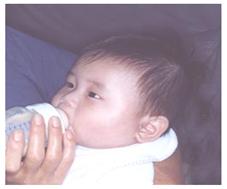
사진 4-102. 아기에게 인공영양을 먹이는 모습
Copyright ⓒ 2011 John Sangwon Lee, MD., FAAP
- 모유도 수유하고 인공영양(참고:인공영양을 포물라 또는 분유라고 한다.)도 먹이는 엄마들이 가끔 있다.
- 이렇게 먹이는 방법을 엄마들은 ‘혼합수유’라고 한다. 인터넷을 통해 소아청소년 건강 상담을 할 때도 수유모들이 ‘혼합수유’란 단어를 자주 쓰고 있는 것을 접했다. 사실 일부 소아청소년과학에 관련 참고서도 ‘혼합수유’란 말을 썼다. 일부 소아청소년과 전문의들도 ‘혼합수유’란 말을 쓰지만, 일반적으로 소아청소년과학에서는 ‘혼합수유’란 단어를 쓰지 않는다. 그러나 여기서도 편의상 ‘혼합수유’란 말을 쓴다.
- 혼합수유는 언뜻 듣기에 이상적 수유 방법 같다. 사실인즉 그렇지 않다. 최고로 좋은 아기 음식물 즉, 엄마의 젖도 먹이면서 모유를 대신 인공영양도 먹이면 신생아들과 영아들이 이상적 음식물을 먹는 것 같이 생각 할 수 있다.
- 그러나 소아청소년과 의사들은 특별한 경우를 제외하고 생후 3~4개월 이전 신생아들이나 영아들에게는 모유만 수유하든지 인공영양만 수유하는 식의 신생아·영아 식이방법을 택하는 것을 전적으로 권장하고 있다.
- 물론 의사들도 ‘혼합수유’란 말을 전적으로 쓰지는 않지만, 부득이한 이유로 모유를 먹는 신생아나 영아가 ‘보충용 인공영양’을 먹을 필요로 있다고 판단될 때, 엄마의 젖만 먹는 아기에게 일시적으로 또는 응급 보충용으로 인공영양을 한두 번 먹일 수 있다.
- 어떤 병이 젖 먹는 아기나 수유모에게 생겼을 때 같이 부득이한 경우, 엄마의 젖을 먹는 아기에게 그 병을 치료하는 목적으로 인공영양을 일시적으로 보충적으로 권하기도 한다.
- 그러나 모유수유하는 수유모가 모유도 먹이고 모유 이외 인공영양을 자유자제로 어느 때든지 먹이면 아기가 엄마의 젖을 적게 먹게 되고, 젖을 적게 먹으면 유방 모유 생성이 적절히 되지 않아 젖이 적게 분비된다.
- 젖이 적게 분비되면 계획하지 안했덩 이유를 해야 하는 상황이 닥칠 수 있다.
- 모유만 먹일 때는 하루에 적어도 8~12번 모유를 수유 할 때도 있고 그에 따라 모유의 분비량이 적절히 조절된다.
- 반면, 모유수유를 하면서 인공영양을 먹일 때는 모유의 분비량이 현저히 감소되어 결과적으로 모유수유를 계속 할 수 없게 된다.
- 즉 모유 분비 양은 수요공급 법칙에 따라 좌우되는 데 혼합 수유를 하면 모유수요공급 법칙이 깨진다.
- 모유수유를 할 때 가능하면 아기에게 보충용 맹물, 포도당 물, 인공영양 등을 먹이지 말라는 것도 이 때문이다.
- 이런 이유로 의사들은 “혼합수유”를 전적으로 권장하지 않는다.
- 이 밖에도 혼합수유에는 한계점이 많다.
- 일단, 수유모는 하루에 몇 번 모유를 수유 할 것인지, 한 번 모유수유를 할 때 몇 분 동안 수유할 것인지, 언제는 모유를 수유 하고 언제는 인공영양을 먹일 것인지 잘 몰라 혼동하게 된다.
- 매번 먹일 수 있는 모유의 양이나 인공영양의 양을 확실히 정하기도 어렵다.
- 혼합수유를 하는 아기는 아기대로 모유의 맛, 인공영양의 맛이 다르다는 것도 알고, 엄마의 젖꼭지와 우유병 꼭지의 촉감이 다르다는 것도 안다.
- 젖꼭지를 빨을 때 모유가 나오는 양과 인공영양을 담은 우유병 꼭지 구멍에서 나오는 양이 달라서 두 가지를 혼동하게 된다.
- 그뿐만이 아니다.
- 모유의 온도와 인공영양의 온도도 서로 차이가 있어 아기에게 혼합수유를 할 때 아기도 혼동하기 쉽다.
- 먹은 모유와 인공영양이 위장 속에서 소화되는 시간에도 차이가 있다.
- 아기에게 어떤 건강 문제가 생겼을 때도 모유수유로 생긴 문제인지 인공영양을 먹어서 생긴 문제인지 판단하기가 어렵다.
- 모유도 먹이고 인공영양도 먹이는 혼합수유를 할 때는 이 밖의 여러 가지 차이점이 많이 있기 때문에 수유모도 아기도 혼동한다.
- 혼합수유를 하면 아기도, 엄마도, 아빠도 모유수유와 인공영양을 혼동하게 되어 결국에는 소아청소년과 단골의사까지 혼동하게 될 것이다.
- 그래서 저자는 “혼합수유”란 말 대신 “혼동수유”란 말을 쓰면 어떤가를 생각도 해봤다.
|
다음은“모유와 분유를 함께 먹어요.”에 관한 인터넷 소아청소년 건강상담 질의응답의 예 입니다. |
Q&A. 모유와 분유를 함께 먹어요
Q.
안녕하세요? 시간 날 때마다 선생님의 글을 읽으며 많은 도움을 받고 있습니다. 저희 아기는 이제 일주일만 있으면 태어난 지 4개월이 되는 남자아기입니다.
1) 아기가 백일 정도 되었을 때 제가 장염에 걸려 고열로 인해 이틀 동안 수유를 못했습니다. 그때 모유의 양이 급격하게 줄어서 enfamil을 같이 먹이고 있습니다. 아침에는 모유를 주고 그 이후에 두 번 정도 모유를 준 다음 중간 중간에 분유를 줍니다. 아가가 분유를 한번 먹는 양은 80~130ml예요. 이렇게 섞여서 먹이다보니 아기가 적정량을 먹고 있는지 잘 모르겠습니다.
2) 모유가 나올 때까지 이런 식으로 혼합수유를 해도 되는 건지 궁금합니다. 아니면 모유를 완전히 끊고 분유만 먹여야 할까요?
3) 그리고 아기가 모유를 잠깐 먹다말고 뒤로 몸을 젖히면서 우는데요. 모유의 양이 부족해서 그러는 거겠죠?
4) 마지막으로 한 가지 더 여쭤볼게요. 아가가 굉장히 자주 놀라거든요. 특히 만세동작을 하고 잠을 자면 어김없이 몇 번씩 놀라 백일 이후부터는 엎어서 재운답니다. 아기가 이렇게 자주 놀라는 것이 좀 자라면 자연스럽게 없어지는 건지요. 그리고 매일 엎어서 재워도 위험하거나 아기에게 해롭지는 않은지 궁금합니다. 그럼 선생님의 답변 기다리겠습니다. 좋은 하루 되세요.
A.
손님
안녕하세요. 질문해 주셔 감사합니다. 아이의 나이, 성별, 과거와 가족의 병력, 진찰소견, 임상검사 결과 등 많은 정보가 있으면 더 좋은 답변을 드릴 수 있습니다. 주신 정보를 참작해 답변을 드립니다.
먼저 첫 번째 질문에 대한 답변입니다.
이 홈페이지를 통해서 소아 건강 상담을 하다가 배운 것이 아주 많습니다.
그중 하나가 ‘혼합수유’라는 용어입니다.
소아청소년과 의사로서 혼합수유라는 단어를 쓰지 않는 것이 옳다고 생각합니다. (p 00 혼합수유 참조)
‘혼합수유’란 말을 쓰면 모유를 먹이는 수유모들에게 “혼합수유”를 해도 괜찮다는 인상을 줄 수 있습니다.
첫 단추를 잘못 끼우는 격이지요. 병원에서 대부분의 수유모들은 분만 후 “내 아기에게 모유 이외에 아무 것도 먹이지 말라”고 간호사에게 요구를 합니다.
때로는 산모 분만회복실 문에 큰 글씨로 “내 아기에게 모유 이외 아무것도 먹이지 마세요, Do not feed anything other than breast milk!”라고 써 붙입니다.
모유의 분비는 수요공급 원칙에 따라 적게 먹으면 적게 분비되고 많이 먹으면 많이 분비됩니다.
모유 이외 Enfamil이란 인공영양을 먹으면 자연적으로 모유 수요량이 줄어들 것이고 모유의 분비가 줄어들 것입니다.
그러나 모유수유도 하고 인공영양(Enfamil)을 먹이면 아기도 혼동하고 수유모도 혼동하고 역시 아기의 소아청소년과 의사도 혼동하게 됩니다.
얼마나 모유를 먹는지 모유 분비는 어느 정도인지 가늠할 수 없습니다. 그러나 아기가 정상적으로 성장하면 모유와 인공영양을 충분히 먹고 있다고 생각할 수 있습니다.
두 번째 질문에 대한 답변입니다.
가능하면 혼합수유를 중지하시고 분유도 먹이지 말고 모유수유를 적어도 생후 9~12개월까지 전적으로 해보시지요.
모유수유를 하면서 가능한 생후 4~6개월부터 보충용 아기 음식물 즉 이유식을 먹여 보시지요. 또 생후 9~12개월 이후에도 모유수유를 계속하세요. 엄마로서 상당히 큰 보람을 느끼실 수 있을 것입니다. 그 값어치는 아주 클 것입니다.
세 번째 질문에 대한 답변입니다.
모유의 양이 부족해서도 그럴 수 있지만 그 가능성은 아주 희박합니다. 모유를 많이 분비해서 모유수유를 계속하시면 그 증상이 곧 없어질 것입니다. 대부분의 수유모들은 두 쌍동 아기가 성장 발육하는데 필요한 충분한 양의 모유를 분비할 수 있습니다.
그래서 두 아기에게 충분한 모유를 동시 수유할 수 있습니다.
저의 딸도 쌍둥이를 키웠는데 둘 다 모유로만 키웠습니다.
드물게 영아산통 등으로 그런 증상이 생길 수 있습니다.
네 번째 질문에 대한 답변입니다.
아기가 놀랠 수 있지만 정상적으로 타고난 원시 반사 모로 반사를 나타내는 것입니다. 어떤 아기는 좀 더 예민해서 모로 반사를 더 자주 나타내기도 합니다.
어떤 부모들은 몇 년 전까지만 해도 아기가 놀랜다고 사약으로 치료하기도 했습니다. 그러나 모로 반사는 아주 정상적으로 타고난 원시 반사입니다.
이 모로 반사는 3~4개월이 되면 자연히 없어집니다. 저는 이 모로 반사 대신 ‘만세반사’라고 부르고 싶습니다.
말씀하신 대로 엎어서 재우면 모로 반사가 덜 해지는 것이 사실입니다.
신생아실에서는 신생아를 따뜻하고 가벼운 포대기로 양팔과 몸통을 싸서 간호하고 양육 합니다. 그렇게 할 때 모로 반사가 잘 나타나지 않는 것을 볼 수 있습니다.
언제까지 등을 바닥에 대고 뉘어 재워야 하는지 확실히는 모르지만 엎치고 뒤치기 시작할 때까지는 등을 바닥에 대고 뉘여 재우는 것이 좋습니다. 그 후에도 계속 그 수면 체위를 제우면 좋습니다.
그렇게 해야 영아돌연사의 발생률이 감소됩니다.
소아청소년과에서 그 문제에 관해 상담하시기 바랍니다. 질문이 더 있으면 또 방문하세요. 감사합니다. 이상원 드림
| 모유수유를 하면서 인공영양을 먹일 때 |
Breastfeeding along with infant formula
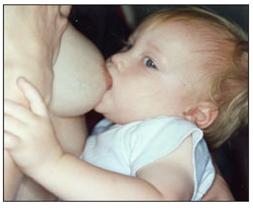
사진 4-103. 모유수유로 아기를 키울 때 생후 4~6개월까지 가능한 한 모유만 먹인다.
Copyright ⓒ 2011 John Sangwon Lee, MD., FAAP

사진 4-104. 모유만 먹는 신생아에게는 모유 이외 인공영양이나 물 등 보충용 음식물을 의사의 지시 없이 먹이지 않는 것이 좋다. 고무젖꼭지(인공 젖꼭지 또는 노리개 젖꼭지)도 꼭 빨릴 필요가 없다.
Copyright ⓒ 2011 John Sangwon Lee, MD., FAAP
- 앞서 혼합수유란 제목 하에서 “모유수유 하면서 인공영양을 먹일 때”에 관해서 설명했다.
- 수유모와 아기가 건강하고 모유수유만을 하는 데 아무 지장이 없을 때는 모유수유를 하면서 구태여 인공영양을 추가로 또는 보충용으로 더 먹일 필요가 없다.
- 모유는 아기의 성장발육에 필요로 하는 모든 영양분과 칼로리가 다 들어 있기 때문이다.
- 특히, 생후 첫 2주 동안은 젖을 주는 수유모와 젖 먹는 아기가 서로 협조해서 모유수유에 관해 또 모유를 먹는 것에 대해 배우고 적응하는 시기다.
- 수유모나 아기에게 건강상으로 어떤 문제가 있는 게 아니라면 이 시기에는 모유 이외 다른 어떤 음식물도 보충용으로 더 먹이지 않는 것이 좋다.
- 신생아들이나 영아들에게 노리개 젖꼭지를 빨리면 노리개 젖꼭지를 빠는 것과 엄마의 젖꼭지를 빠는 것을 때로 혼동하게 된다.
- 가능한 한 노리개 젖꼭지를 아기가 빨게 하지 않는 것이 좋다.
- 신생아들이나 영아들에게 모유의 보충용으로 맹물, 포도당 물, 또는 인공영양을 빨아먹게 우유병에 담아주면 자연적으로 엄마의 젖꼭지를 빨아먹는 흡철 반사가 줄어든다.
- 또 그 보충용 음식물과 수액을 먹는 아기는 그 날 필요로 하는 수분과 영양분을 보충용 음식물과 수액 섭취에서 다소 섭취할 수 있어 엄마의 젖을 덜 빨고 덜 먹게 된다. 자연스레 엄마의 유방도 모유를 덜 분비하게 된다.
- 연구에 의하면, 신생아들이 모유 이외 수분을 추가로 또는 보충용으로 섭취한다고 해서 빌리루빈의 신진대사나 분비가 더 촉진되는 것은 아니라고 한다. 이런 이유로 의학적으로 특수한 상황을 제외하고 모유를 수유하면서 인공영양을 보충적으로 더 먹이는 것을 권장하지는 않는다.
Breastfeeding and supplemental feeding for additional supplemental nutrients other than breast milk. 모유 이외 다른 보조 영양분을 더 먹이려면
Breastfeeding and supplemental feeding
1. Water and liquids
There are also nursing mothers who ask, “Can I feed my baby with fresh water separately?” The amount of moisture in 100cc of breast milk is about 87cc.
Even if the baby eats enough milk, it can grow and develop normally with the water ingested from breast milk.
If you feed a lot of water other than breast milk, your baby can urinate more often and eat less mother’s milk. When the temperature and humidity in the room where the baby is located is adequate and the baby is physically active, there is no need to add water to the baby who is fully breastfed. However, during the hot summer months, when the indoor temperature is quite high, or when you sweat a lot, you can sometimes feed a baby with boiled barley tea water or plain water with a milk bottle.
There are also nursing mothers who are worried that their babies have constipation when they do not see the stool every 2 to 3 days or see it once or twice.
Depending on your baby’s age, if you feed plain water occasionally, your baby may have a bowel movement. Boiled and cooled freshwater can be fed before 4 months of age, and unboiled drinking water can be fed after that. When your baby is dehydrated, the interval between urine flows increases and the amount of urine decreases.
If you suspect that your baby is dehydrated, you can feed enough milk and add more plain water. When a nursing mother consumes more fluids than usual, it produces more milk and does not need to feed the baby separately.
2 vitamin preparations

Photo 4-96. Multivitamin drop for infants and toddlers. Source: Used with permission from Mead Johnson Nutritionals, USA

Photo 4-97. Various types of vitamins on display at local pharmacies. Copyright ⓒ 2011 John Sangwon Lee, MD., FAAP
Infants raised with breast milk from nursing mothers who have consumed enough balanced foods from 6 to 9 months after delivery can get enough vitamins from their breast milk.
On the other hand, when a nursing mother does not eat evenly or does not eat enough, the vitamins and minerals that infants need cannot be sufficiently consumed from breast milk. From 3 to 4 months of age, multivitamin drops containing iron and vitamins A, B and D are given to infants breastfeeding according to the doctor’s prescription. Infants who are breastfeeding after 4 months of age may be given a drop of a multivitamin for infants containing iron. Then take a drop of fluoride as directed by your doctor.
Newborns who are breastfed are also routinely given vitamin K injections in hospital neonatal rooms.
Table 5-2. Foods high in vitamins and types of vitamins 표 5-2. 비타민이 많이 들어있는 음식물과 비타민 종류
| Types of vitamins | Foods high in vitamins | Types of vitamins | Foods high in vitamins |
| Vitamin A | Butter, eggs, liver, etc | Pyridoxine | liver, meat, grains, corn, beans, etc. |
| Provitamin A | Dark green vegetables, yellow fruits, and vegetables, | riboflavin | meat such as tomatoes, milk, eggs, green vegetables, grains, etc. |
| Biotin | liver, egg yolk, peanut, etc. | Thiamine | liver, meat, milk, grain logistics, etc. |
| Vitamin B12 | Meat, milk, eggs, etc. | vitamin C | sour fruit, tomatoes, cabbage, potatoes, breast milk, etc |
| Folic acid | liver, green vegetables, grains, oranges, etc. | vitamin D | milk, fish, liver, sardines, mackerel, salmon, egg yolk, etc |
| Niacin | meat, fish, green vegetables, grains, etc | vitamin E | peanuts, soy milk, butter, grain oil, etc. |
| Phentanenic acid | contained in most foods | vitamin K | milk, green vegetables, pork, liver, etc |
When feeding artificial nutrition and breast milk to a premature newborn baby
Breast milk with Infant formula feeding for premature infants Nutrients (carbohydrates, fats, proteins, moisture, minerals, vitamins A, B, C, D, etc.). It is adequately contained in the inside. Therefore, newborns born at full term who are breastfed by a mother who consumes enough balanced foods do not need additional multivitamins and iron supplements.
However, infants who are breastfeeding are advised to take more multivitamins and iron separately according to the doctor’s prescription.
Unless directed by a doctor, full-term newborns, underweight newborns, and premature newborns who eat artificial nutrition do not need additional nutrients such as vitamins. However, it is better to feed colostrum and breastfeed as much as possible.

Photo 4-98. A milk bottle for immature newborns that makes it easier for underweight and immature newborns to eat artificial nutrition. Copyright ⓒ 2012 John Sangwon Lee, MD., FAAP

Photo 4-99. Very small, premature and underweight newborns can be fed a special high-calorie formula as needed. For example, there is also special artificial nutrition for immature newborns in which 24kcl of calories are produced in 30CC of artificial nutrition. Copyright ⓒ 2012 John Sangwon Lee, MD., FAAP

Photo 4-100. Special artificial nutrition for low birth weight and premature newborns. It produces more calories in a unit dose of artificial nutrition. Copyright ⓒ 2012 John Sangwon Lee, MD., FAAP
The following is an example of the online pediatric and adolescent health counseling question and answer on “nutrition for immature newborns”.
Q.&A.
Internet Q&A on “nutrition for immature newborns”
Q.
A 6-month-old boy, born 1.7kg, was hospitalized in an incubator for a month. He was discharged from the hospital, eats well and grew up like other children until 100 days, but the baby does not eat well after 100 days. Ha It only eats about 500ml in the rue. He heard that the baby has a cycle that eats well and that there is a cycle that he doesn’t eat. If you eat baby food, you don’t eat any more formula. That doesn’t mean I eat a lot of baby food. I’m worried about why. If you have any good words, please.
A.
General Hello. Thanks for asking. First, the current baby’s weight, how much is the new device? Knowing more about your past medical history, current medical history, family medical history, and what kind of artificial nutrition you feed every few hours and how many times a day can be very helpful in giving you an answer.
I am curious about how many calories can be produced from artificial nutrition 30cc, and also how many weeks of pregnancy you gave birth to a baby. Having such information will help us respond. When you started feeding baby food, you need to know what kind of baby food you feed, how much at a time, and how many times a day to give an answer. For example, there are artificial nutrition for immature newborns that produce 24 calories from 30 ccs of artificial nutrition, and there is also artificial nutrition for general use that produces 20 calories from 30 ccs of artificial nutrition. That’s why it’s important to know what kind of artificial nutrition you feed your children. When you eat artificial nutrition that can produce calories from 30 ccs to 20 calories, and when you eat artificial nutrition that produces calories from 30 ccs to artificial nutrition, the intake of artificial nutrition may be naturally small.
The more baby food you eat, the less artificial nutrition you eat. A 6-month-old infant weighing 7.3kg has an average total water intake of 950-1100cc per day, and it is common to consume 130-150cc of water per 1kg of body weight per day. Also, the daily calorie required per 1kg of body weight is 80 to 120 calories.
Find out if your baby’s predicted weight and height are increasing normally along the weight percentile and height percentile on the growth chart. You can find out at your regular Pediatrics Department. You need to know if you are an immature newborn born in the weeks of pregnancy and feed baby food such as artificial nutrition.
After 6 months, most infants hate sleeping alone because they can have separation anxiety phobia. Infants of this age have a fairly pronounced habit of eating food, depending on their diet.
Do not give food when you are not hungry, or shake your head from side to side if you give food that you do not want to eat, or lean your body and neck back to receive food.
Sometimes I keep my mouth shut. In addition, if you eat a lot of baby food foods such as vegetable juices or fruit juices, the amount of artificial nutrients your baby can eat naturally decreases. Anemia, especially in premature newborns, can be healed early and may become worse.
He may not eat the right amount of food with any medical condition, such as anemia.
He may not eat the right amount of food with any medical condition, such as anemia.
The child’s age is 6 months, but when it comes to gestational age, it is not yet 6 months old. With that in mind, it is also important to feed artificial nutrition or baby food. For these and other reasons, please consult with the Department of Pediatrics and Adolescents after receiving a check-up diagnosis treatment. If you have more questions, please visit again. Thank you. Lee Sang-won .MD
Mixed and confused lactation.
Breastfeeding along with infant formula feeding

Photo 4-101.Breastfeeding baby. Copyright ⓒ 2011 John Sangwon Lee, MD., FAAP

Photo 4-102. Feeding a baby with artificial nutrition. Copyright ⓒ 2011 John Sangwon Lee, MD., FAAP
• Sometimes mothers are breastfeeding and feeding artificial nutrition (reference: artificial nutrition is referred to as formula or formula).
• This feeding method is called ‘mixed feeding’ by mothers.
When providing health counseling for children and adolescents through the Internet, I noticed that nursing mothers often use the word “mixed feeding”. In fact, some reference books related to pediatric and adolescent science also used the term “mixed feeding”.
Some pediatric and adolescent specialists also use the word “mixed feeding”, but pediatric and adolescent science generally does not use the word “mixed feeding”. However, the term “mixed feeding” is also used here for convenience.
• Mixed feeding seems to be the ideal feeding method at first glance. If it is true, it is not. The best baby food, that is, feeding mother’s milk while feeding artificial nutrition instead of breast milk, can be thought of as eating the ideal food for newborns and infants.
• However, pediatricians and adolescents fully recommend that newborns and infants before 3-4 months of age, except for special cases, choose the method of feeding only breastfeeding or artificial nutrition for newborns and infants.
• Of course, doctors do not use the term mixed feeding’ entirely, but when it is judged that a newborn or infant who is breastfed for an unavoidable reason needs to take supplementary nutrition’, it is temporarily or emergency As a supplement, artificial nutrition can be given once or twice.
• When a disease is unavoidable, such as when a baby is nursing or a nursing mother, the mother’s breastfeeding baby may be temporarily supplemented with artificial nutrition for the purpose of curing the disease.
• However, if a breastfeeding mother feeds breast milk and freely feeds artificial nutrition other than breast milk at any time, the baby will eat less milk from the mother, and if less milk is consumed, breast milk production will not be adequate and less milk will be secreted.
• Lack of milk can lead to unplanned reasons.
• When breastfeeding only, breastfeeding is performed at least 8-12 times a day, and the amount of milk secretion is appropriately controlled accordingly.
• On the other hand, when artificial nutrition is fed while breastfeeding, the amount of secretion of breast milk is significantly reduced, resulting in the inability to continue breastfeeding.
• In other words, the amount of breast milk secretion depends on the law of supply and demand. When mixed feeding, the law of demand and supply of breast milk is broken.
• This is why when breastfeeding, if possible, avoid feeding your baby with supplementary plain water, glucose water, or artificial nutrition.
• For this reason, doctors do not entirely recommend “mixed feeding”.
• In addition, there are many limitations to mixed feeding.
• First of all, nursing mothers are confused because they do not know how many times a day will breastfeed, how many minutes to breastfeed once, and when to breastfeed and when to feed artificial nutrition.
• It is difficult to determine the amount of breast milk or artificial nutrition that can be fed each time.
• A baby who is mixed-feeding knows that the taste of breast milk and artificial nutrients are different from each other and that the mother’s nipple and the teat of the milk bottle are different from each other.
• Confusing the two is because the amount of breast milk comes out of the nipple when you suck it and the amount that comes out of the top hole of the bottle containing artificial nutrition is different.
• Not only that.
• The temperature of breast milk and the temperature of artificial nutrients are also different, so it is easy for babies to get confused when mixed feeding a baby. • There is also a difference in the amount of time that breast milk and artificial nutrients are digested in the stomach.
• Whenever a baby has any health problems, it is difficult to determine if it is a problem caused by breastfeeding or from eating artificial nutrition.
• When breastfeeding and artificial nutrition are fed, there are many other differences between breastfeeding and artificial nutrition, which confuses both nursing mothers and babies.
• When mixed feeding, both babies, mothers, and fathers will confuse breastfeeding with artificial nutrition, which will eventually confuse children and adolescents with regular doctors.
• So, the author thought about how to use the word “mixed feeding” instead of “mixed feeding”.
The following is an example of a question-and-answer on the Internet pediatric and adolescent health counseling on “Eat breast milk and formula together.” Q&A.
I eat breast milk and formula together
Q.
Good morning? Whenever I have time, I read the teacher’s writing and receive a lot of help. My baby is now 4 months old in just one week.
1) When my baby was about 100 days old, I got enteritis and I couldn’t breastfeed for two days due to a high fever.
At that time, the amount of breast milk drastically decreased, so I am feeding Enfamil together. Breastfeeding is given in the morning, followed by two breastfeeding, followed by formula in the middle.
The amount of the baby’s milk powder is 80-130ml. I am not sure if my baby is eating the right amount because it is mixed and fed.
2) I wonder if it is okay to mix breastfeeding in this way until breast milk comes out. Or should I stop breastfeeding completely and feed only formula?
3) And the baby cries while leaning back after eating breast milk for a while. It’s because the amount of breast milk is insufficient, right?
4) Lastly, I’ll ask you one more thing. The baby is surprised very often. In particular, when I go to bed after hurraying, I am surprised several times without fail, and after a hundred days, I turn upside down and sleep. What surprises your baby so often will disappear naturally as you grow up. And I wonder if sleeping upside down every day is dangerous or harmful to the baby. Then I look forward to your answer. Have a nice day.
A.
Good morning. Thank you for asking.
If you have a lot of information such as the child’s age, gender, past and family medical history, medical examination findings, and clinical test results, we can give you a better answer. We will respond by taking the information you provided into consideration. First is the answer to the first question.
There are a lot of things I learned while consulting on children’s health through this website. One of them is the term mixed feeding’.
As a pediatrician, I think it is correct not to use the word mixed feeding. (Refer to Mixed Feeding) The use of the term “mixed feeding” can give the impression that “mixed feeding” is okay to breastfeeding mothers. It’s like putting the first button in the wrong way. In hospitals, most nursing mothers ask their nurses to “don’t feed my baby anything other than breast milk” after delivery. Sometimes the door of the maternity recovery room is written in large print,
“Do not feed anything other than breast milk!”.
According to the principle of supply and demand, the secretion of breast milk is less secreted if you eat less, and more secreted if you eat more.
In addition to breast milk, eating an artificial diet called Enfamil will naturally reduce your milk demand and reduce your milk production.
However, breastfeeding and feeding artificial nutrition (Enfamil) confuse the baby, the nursing mother and the baby’s pediatricians and doctors.
You cannot tell how much you are breastfed or how much your milk is secreted. However, if your baby is growing normally, you may think that you are getting enough breast milk and artificial nutrition.
This is the answer to your second question.
If possible, stop mixed feeding, do not feed formula, and try breastfeeding completely until at least 9-12 months of age.
While breastfeeding, try feeding supplementary baby food, that is, baby food, starting from 4-6 months of age as much as possible.
Also, continue breastfeeding after 9-12 months of age. As a mother, you will find it very rewarding.
The value will be very high.
This is the answer to the third question.
This may be due to an insufficient amount of breast milk, but it is very unlikely.
If you continue breastfeeding because you secrete a lot of breast milk, the symptoms will soon go away.
Most nursing mothers are able to produce enough milk for both twin babies to grow and develop.
So you can feed both babies with enough breast milk at the same time. My daughter also raised twins, both of which were only breast milk. Rarely, such symptoms can be caused by infant colic or the like.
This is the answer to the fourth question.
Your baby may be surprised, but it’s normally a natural primitive reflex that shows a reflex. Some babies are more sensitive and have more frequent Moro reflexes. Some parents even treated their babies with drugs just a few years ago because they were surprised.
However, the Moro reflex is a very normal innate primitive reflex. This Moro reflex disappears naturally after 3-4 months.
Instead of this Moro reflection, I would like to call it ‘Hanse-B’ It is true that if you sleep upside down as you said, the reflection will be less. In the neonatal room, the newborn is nursing and nursing newborns by wrapping their arms and torso with warm, light swaddling. When you do that, you can see that the Moro reflection doesn’t appear well. You’re not sure how long you need to lay your back on the floor, but it’s a good idea to lay your back on the floor until you start flipping over.
After that, it is good to continue to remove the sleeping position. This will reduce the incidence of sudden infant death.
Please consult with the Department of Pediatrics and Adolescents about the problem. If you have more questions, please visit again. Thank you. Lee Sang-won .MD
When feeding artificial nutrition while breastfeeding
Breastfeeding along with infant formula

Photo 4-103. When raising a baby by breastfeeding, feed only breast milk as much as possible from 4 to 6 months of age. Copyright ⓒ 2011 John Sangwon Lee, MD., FAAP

Photo 4-104. Newborns who only eat breast milk are advised not to feed supplementary foods such as artificial nutrition or water other than breast milk without a doctor’s instructions. The nipples (artificial nipples or soothers) don’t necessarily need to be sucked. Copyright ⓒ 2011 John Sangwon Lee, MD., FAAP
• Previously, under the heading of mixed lactation, we explained about “when feeding artificial nutrition while breastfeeding”.
• When the nursing mother and baby are healthy and breastfeeding is not a problem, there is no need to supplement or supplement artificial nutrients while breastfeeding.
• This is because breast milk contains all the nutrients and calories needed for the baby’s growth and development.
• Particularly during the first two weeks of life, it is a time when a nursing mother and a nursing baby cooperate with each other to learn and adjust about breastfeeding and breastfeeding.
• It is advisable to stop feeding any food other than breast milk at this time as a supplement unless the nursing mother or baby has any health problems
. • Sucking soother nipples on newborns or infants sometimes confuses sucking soother nipples with sucking on mother’s nipples
• If possible, it is best not to let your baby suck on the pacifier.
• Feeding newborns or infants in a bottle of freshwater, glucose water, or artificial nutrients as a supplement to breast milk reduces the absorption reflex that naturally sucks the mother’s nipples.
• In addition, a baby who eats the supplemental food and sap can get some water and nutrients needed for the day from the supplemental food and fluid intake, so that the mother sucks and eats less. Naturally, the mother’s breasts also produce less milk.
• Studies have shown that bilirubin’s metabolism or secretion is not accelerated when newborns consume additional or supplemental fluids other than breast milk. For this reason, it is not recommended to supplement supplementary feeding of artificial nutrition while breastfeeding, except in medically specific circumstances.
출처 및 참조 문헌
- NelsonTextbook of Pediatrics 22ND Ed
- The Harriet Lane Handbook 22ND Ed
- Growth and development of the children
- Red Book 32nd Ed 2021-2024
- www.drleepediatrics.com 제1권 소아청소년 응급 의료
- www.drleepediatrics.com 제2권 소아청소년 예방
- www.drleepediatrics.com 제3권 소아청소년 성장 발육 육아
- www.drleepediatrics.com 제4권 모유,모유수유, 이유
- www.drleepediatrics.com 제5권 인공영양, 우유, 이유식, 비타민, 미네랄, 단백질, 탄수화물, 지방
- www.drleepediatrics.com 제6권 신생아 성장 발육 육아 질병
- www.drleepediatrics.com제7권 소아청소년 감염병
- www.drleepediatrics.com제8권 소아청소년 호흡기 질환
- www.drleepediatrics.com제9권 소아청소년 소화기 질환
- www.drleepediatrics.com제10권. 소아청소년 신장 비뇨 생식기 질환
- www.drleepediatrics.com제11권. 소아청소년 심장 혈관계 질환
- www.drleepediatrics.com제12권. 소아청소년 신경 정신 질환, 행동 수면 문제
- www.drleepediatrics.com제13권. 소아청소년 혈액, 림프, 종양 질환
- www.drleepediatrics.com제14권. 소아청소년 내분비, 유전, 염색체, 대사, 희귀병
- www.drleepediatrics.com제15권. 소아청소년 알레르기, 자가 면역질환
- www.drleepediatrics.com제16권. 소아청소년 정형외과 질환
- www.drleepediatrics.com제17권. 소아청소년 피부 질환
- www.drleepediatrics.com제18권. 소아청소년 이비인후(귀 코 인두 후두) 질환
- www.drleepediatrics.com제19권. 소아청소년 안과 (눈)질환
- www.drleepediatrics.com 제20권 소아청소년 이 (치아)질환
- www.drleepediatrics.com 제21권 소아청소년 가정 학교 간호
- www.drleepediatrics.com 제22권 아들 딸 이렇게 사랑해 키우세요
- www.drleepediatrics.com 제23권 사춘기 아이들의 성장 발육 질병
- www.drleepediatrics.com 제24권 소아청소년 성교육
- www.drleepediatrics.com 제25권 임신, 분만, 출산, 신생아 돌보기
- Red book 29th-31st edition 2021
- Nelson Text Book of Pediatrics 19th- 21st Edition
- The Johns Hopkins Hospital, The Harriet Lane Handbook, 22nd edition
- 응급환자관리 정담미디어
-
소아가정간호백과–부모도 반의사가 되어야 한다, 이상원
-
Neonatal Resuscitation American heart Association
-
Neonatology Jeffrey J.Pomerance, C. Joan Richardson
-
Pediatric Resuscitation Pediatric Clinics of North America, Stephen M. Schexnayder, M.D.
-
Pediatric Critical Care, Pediatric Clinics of North America, James P. Orlowski, M.D.
-
Preparation for Birth. Beverly Savage and Dianna Smith
-
Infectious disease of children, Saul Krugman, Samuel L Katz, Ann A. Gershon, Catherine Wilfert
- Pediatric Nutritional Handbook American Academy of Pediatrics
- 소아가정간호백과–부모도 반의사가 되어야 한다, 이상원
- The pregnancy Bible. By Joan stone, MD. Keith Eddleman, MD
- Neonatology Jeffrey J. Pomerance, C. Joan Richardson
- Preparation for Birth. Beverly Savage and Dianna Smith
- 임신에서 신생아 돌보기까지. 이상원
- Breastfeeding by Ruth Lawrence and Robert Lawrence
- Infectious disease of children, Saul Krugman, Samuel L Katz, Ann A. Gershon, Catherine Wilfert
- The Harriet Lane Handbook 19th Edition
- 제4권 모유, 모유수유, 이유 참조문헌 및 출처
- 제5권 인공영양, 우유, 이유, 비타민, 단백질, 지방 탄수 화물 참조문헌 및 출처
- 제6권 신생아 성장발육 양호 질병 참조문헌 및 출처
- 소아과학 대한교과서
- 그 외
|
Copyright ⓒ 2015 John Sangwon Lee, MD, FAAP 미국 소아과 전문의, 한국 소아청소년과 전문의 이상원 저 “부모도 반의사가 되어야 한다”-내용은 여러분들의 의사로부터 얻은 정보와 진료를 대신할 수 없습니다. “The information contained in this publication should not be used as a substitute for the medical care and advice of your doctor. There may be variations in treatment that your doctor may recommend based on individual facts and circumstances. “Parental education is the best medicine.” |